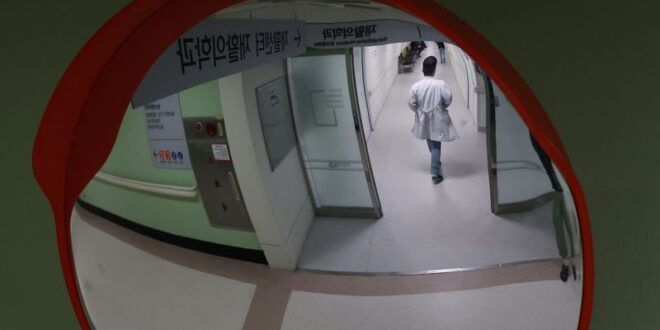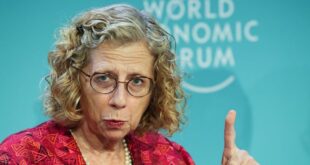(Reuters) – Thousands of trainee doctors in South Korea have walked off the job in the past two weeks to protest a government plan to admit more students into medical schools, as both sides in the dispute argue over what is needed to fix the healthcare system.
Authorities say more doctors are required in remote areas and to meet growing demands in a rapidly ageing society, but many doctors say pay and work conditions skewing the healthcare system should be addressed first.
Here are some details about South Korea’s medical system and the current dispute.
DOCTORS BY THE NUMBERS
South Korea has a universal healthcare system funded by a public health insurance system though most doctors work in private practices and hospitals are usually privately owned.
The doctor-to-patient ratio of 2.6 per 1,000 people is one of the lowest among developed countries, according to data from the Organisation of Economic Cooperation and Development (OECD) countries. In contrast, top ranked Austria has 5.5 doctors per 1,000 people.
The government plans to increase admissions to medical schools by 2,000 starting in 2025 from 3,000 now to fill what it projects to be a large shortfall of doctors by 2035.
Some medical professionals point out the government’s plans will do little to fix the near-term situation as they lack proper measures to shore up essential services and rural areas grappling with a deepening shortage of doctors. It also takes around 10 years for a doctor to be fully trained.
Since the walkout started on Feb. 20 about 70% of trainee doctors, or about 9,000, have left their posts, the health ministry says.
But while the dispute only involves around 7% of the 135,000 licensed doctors, based on 2023 ministry data, trainees make up at least 40% of staff at some major hospitals, forcing them to turn away some patients and cancel medical procedures.
COMPENSATION
South Korea’s specialist doctors are, on average, some of the highest paid among developed countries, with an average annual income of $192,749 in 2020, according to OECD data.
General practitioners, however, are paid less and there is also a significant disparity in specialists’ income, according to health ministry data. Paediatricians are the lowest paid, making 57% less than the overall average. Plastic surgeons and dermatologists in private practice are usually better paid.
One trainee doctor involved in the dispute told Reuters he worked over 100 hours a week at a top university hospital for 2 million won to 4 million won ($1,500-$3,000) a month including overtime pay. A first-year U.S. resident averages about $5,000 a month, according to American Medical Association data.
MEDICAL FEES
Under South Korea’s national health insurance system, hospitals can only receive a fixed fee for “essential” medical care from patients, but fees set by the government were often too low to cover costs, some doctors say.
This had led to doctors shunning “essential” medical fields such as neurosurgery, emergency care and paediatrics, and instead going into fields such as dermatology and cosmetic surgery where they can make money off procedures that are not insured, they said.
The government has said its plan will lift investment and doctors’ pay in regional and rural areas and that it has raised fees in essential services and will inject more than 10 trillion won ($7.5 billion) to boost these fees over five years.
PUBLIC SUPPORT
The plan to boost medical school admissions is popular with the public. A Gallup Korea poll found about 76% of respondents in favour of the policy, regardless of political affiliation.
Another survey published on Tuesday by the Yonhap news agency found 84% of respondents supported adding more doctors, while 43% said striking physicians should be sternly punished.
Accordingly, President Yoon Suk Yeol’s approval ratings have edged up with critics accusing him of picking a fight over medical reforms to benefit his party ahead of parliamentary elections in April.
Yoon also maintained a similar hard-line stance over a strike by truckers in 2022, even as it disrupted supply chains and threatened key industries.
HOW MIGHT THE DISPUTE PLAY OUT?
In 2020, Yoon’s predecessor, Moon Jae-in, shelved a plan to boost doctor numbers after a strike by doctors that also coincided with a wave of coronavirus infections, an outcome that is likely to increase the resolve of protesters.
Nonetheless, the government has recently rolled out measures to ride out the dispute including by using military doctors and giving nurses authority to conduct some procedures usually done by doctors.
Moreover, authorities have threatened striking doctors with legal and administrative action, such as suspending or revoking medical licences or even potential fines and jail time for breaching medical law.
($1 = 1,333.1400 won)
(Reporting by Ed Davies and Hyonhee Shin, Additional repoting by Joyce Lee, Jack Kim and Ju-min Park; Editing by Michael Perry)
 BeritaKini.biz Berita Viral Terkini di Malaysia
BeritaKini.biz Berita Viral Terkini di Malaysia





